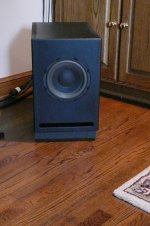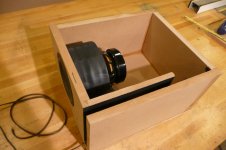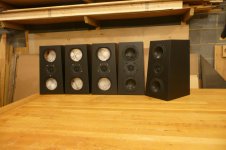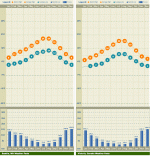I’ve been building HT subs for many years and this is my favorite design. [/FONT][/COLOR]These subs have super low bass and out perform many store bought boxes.
Two long throw 8” woofers ($30 each) mounted isobaric, using small tunnel. Tunnels sound complicated, but they are pretty easy, simply use square blocks of wood with the same size hole as the woofer, laminated (glue) as needed. In this box I found that a 5” total inside depth works well. [/FONT][/COLOR]Also note; I used 1” thick wood, so bracing not needed.
The speakers are 4ohm, so ran them in series and bridged a 200 watt amp mono to drive them, an option is to run them 4ohm stereo.
Two long throw 8” woofers ($30 each) mounted isobaric, using small tunnel. Tunnels sound complicated, but they are pretty easy, simply use square blocks of wood with the same size hole as the woofer, laminated (glue) as needed. In this box I found that a 5” total inside depth works well. [/FONT][/COLOR]Also note; I used 1” thick wood, so bracing not needed.
The speakers are 4ohm, so ran them in series and bridged a 200 watt amp mono to drive them, an option is to run them 4ohm stereo.
Attachments
I was reading a book (the old "The Secrets of Car Audio") the other day that suggested an isobaric design.
It clearly stated that an isobaric alignment will have lower resonance because the air space between the woofers will act as a buffer of sorts.
What size is the box, port length and how much air do you have in the air space between the woofers?
It clearly stated that an isobaric alignment will have lower resonance because the air space between the woofers will act as a buffer of sorts.
What size is the box, port length and how much air do you have in the air space between the woofers?
Tunnel
The tunnel is 5” deep inside, with 7” hole cut in the lamented pieces. I did seal the tunnel with rubber spray. I will provide the measurements ASAP. Woofers: MCM Part #: 55-2421
I did make other versions with face to face designs, I think they have a little more output and easier to build, but not much to look at.
Btw, Isobaric has been around a long time, mid 1950s
The tunnel is 5” deep inside, with 7” hole cut in the lamented pieces. I did seal the tunnel with rubber spray. I will provide the measurements ASAP. Woofers: MCM Part #: 55-2421
I did make other versions with face to face designs, I think they have a little more output and easier to build, but not much to look at.
Btw, Isobaric has been around a long time, mid 1950s
Doesn't face-to-face (clamshell) design effectively require twice the volume as compared to a true isobaric design?
Oh, do you have an frequency response chart?
Thanks for the measurements, I am currently trying to work out a "compact" design around 50 to 66 Liters for portable needs (outdoors use) with a high output to match the "Boominator" design, when a little more 'uupmh' is needed.
Not sure it is doable with only 100 Watt (Tripath TAA4100A based) available though.
Oh, do you have an frequency response chart?
Thanks for the measurements, I am currently trying to work out a "compact" design around 50 to 66 Liters for portable needs (outdoors use) with a high output to match the "Boominator" design, when a little more 'uupmh' is needed.
Not sure it is doable with only 100 Watt (Tripath TAA4100A based) available though.
face to face, back to back, front to back
I believe that face to face, back to back, front to back is all the same, so the box volume is cut in half. No frequency chart, however many hours of testing and building boxes. I’m a Cabinetmaker by trade, so very light on the engineering, but have cranked out many cabinets. One thing I came up for tuning: semi build the box, to the point where the front plate can be slid up and down, which changes the port’s volume - using a generator and volt meter you can tune the box with certainly and then do the final glue up (works every time, but you need a good number of clamps).
Only a 100 watts? You’re probably going to need more power, however, this design did rock the shop with a old Rotel 60 watt per channel amp and an a small car crossover, set at 50hz
I believe that face to face, back to back, front to back is all the same, so the box volume is cut in half. No frequency chart, however many hours of testing and building boxes. I’m a Cabinetmaker by trade, so very light on the engineering, but have cranked out many cabinets. One thing I came up for tuning: semi build the box, to the point where the front plate can be slid up and down, which changes the port’s volume - using a generator and volt meter you can tune the box with certainly and then do the final glue up (works every time, but you need a good number of clamps).
Only a 100 watts? You’re probably going to need more power, however, this design did rock the shop with a old Rotel 60 watt per channel amp and an a small car crossover, set at 50hz
Isobaric designs normally half the required box volume, if built like the OPs or as a clamshell or mag-to-mag.
However, if you clamshell or mag-to-mag mount the drivers, wiring one out of phase, you create a much cleaner output as 2nd order harmonics are cancelled by the opposing motion of the drivers-though surprisingly a lot of people don't like that as much as bass with the 2nd order harmonics!
Removing the 2nd order harmonics is very useful for car audio as the sub is normally located behind the listener and the 2nd order harmonics are what "pull your ears back" making the sub locatable-assuming you've got it crossed over low enough for the fundementals not be located (63Hz and down)
Obviously there is crossover into HT if the sub is going to be placed away from the main drivers/screen.
However, if you clamshell or mag-to-mag mount the drivers, wiring one out of phase, you create a much cleaner output as 2nd order harmonics are cancelled by the opposing motion of the drivers-though surprisingly a lot of people don't like that as much as bass with the 2nd order harmonics!
Removing the 2nd order harmonics is very useful for car audio as the sub is normally located behind the listener and the 2nd order harmonics are what "pull your ears back" making the sub locatable-assuming you've got it crossed over low enough for the fundementals not be located (63Hz and down)
Obviously there is crossover into HT if the sub is going to be placed away from the main drivers/screen.
Doesn't face-to-face (clamshell) design effectively require twice the volume as compared to a true isobaric design?
No, they are the "same". Face-to-face just gives the smallest coupling volume (althou usually ignored, coupling cavity adds to the volume of the box). A smaller coupling cavity also extends the HF response (shorter distances means that cancelation ripple is pushed upwards)
dave
However, if you clamshell or mag-to-mag mount the drivers, wiring one out of phase, you create a much cleaner output as 2nd order harmonics are cancelled by the opposing motion of the drivers-though surprisingly a lot of people don't like that as much as bass with the 2nd order harmonics!
Not surprising at all. It has pretty much been established that the harmonics of the distortion products should monotonically decrease. If you reduce the 2nd harmonic below the 3rd it can sound unnatural.
Further, Geddes has shown that (measured) distortion needs to get pretty high before it becomes audible.
dave
I did try wiring the woofers so they are pushing against each other, I didn’t get much sound output. I found that moving the cones in same directions works the best.
Several years ago I had two pairs of Peerless 12” woofers, clamshell mounted (4 woofers total) in a 6cf cabinet; it worked but the bass was so slow to get going, a lot was lost, before it ever got started.
The 8’s are super quick, they have powerful bass and the sound stays in the room (not louder/deeper in the adjacent room). Typically the bass is strong without a lot of cone movement, but warning, they will bottom out!
Oh btw, I use the bass limiter setting in a Lexicon processor so I don’t over drive them (explosions are the worst). The old Lexicon DC’s and MC’s are perfect for DIY, with built in crossovers and sub sonic limiter.
Several years ago I had two pairs of Peerless 12” woofers, clamshell mounted (4 woofers total) in a 6cf cabinet; it worked but the bass was so slow to get going, a lot was lost, before it ever got started.
The 8’s are super quick, they have powerful bass and the sound stays in the room (not louder/deeper in the adjacent room). Typically the bass is strong without a lot of cone movement, but warning, they will bottom out!
Oh btw, I use the bass limiter setting in a Lexicon processor so I don’t over drive them (explosions are the worst). The old Lexicon DC’s and MC’s are perfect for DIY, with built in crossovers and sub sonic limiter.
The advantage of an Isobaric design is smaller size for a given F3.Thanks for the measurements, I am currently trying to work out a "compact" design around 50 to 66 Liters for portable needs (outdoors use) with a high output to match the "Boominator" design, when a little more 'uupmh' is needed.
Not sure it is doable with only 100 Watt (Tripath TAA4100A based) available though.
The disadvantage of an Isobaric design is they only have the same output of a single driver, rather than the 6 dB gain when cone area and power is doubled.
If you are looking for the most bass "umph" with low power, in a relatively small enclosure, the SS15 or THAM or similar tapped horn would probably be the best bet.
Finish Measurements:
Finish Measurements:
Wood is 3/4” MDF
11 1/2 Wide 17” Tall 19” Deep.
The port is 10” wide x 13-1/2” deep x 11/16” high (slightly less than 3/4”).
It’s fairly easy to build, rip 10” boards for front, top, bottom and port. The tunnel can be make with 10” square slabs with a 7” hole, laminate them together. Obliviously the cone should not hit the back of the magnet of the front speaker.
I do recommend a table saw, router and several clamps. Take your time building the tunnel, the box will assemble quickly.
What I like about this cabinet design is the tuning, both “humps” are equal and the dip is at 31hz. The emphasis for this box is super low, quick response bass, all at a good price (-; (-;
Yes I do know the pic is 1” MDF, 1” is hard to handle and it’s expensive, these are dimensions for second box that I built using 3/4 material.
Finish Measurements:
Wood is 3/4” MDF
11 1/2 Wide 17” Tall 19” Deep.
The port is 10” wide x 13-1/2” deep x 11/16” high (slightly less than 3/4”).
It’s fairly easy to build, rip 10” boards for front, top, bottom and port. The tunnel can be make with 10” square slabs with a 7” hole, laminate them together. Obliviously the cone should not hit the back of the magnet of the front speaker.
I do recommend a table saw, router and several clamps. Take your time building the tunnel, the box will assemble quickly.
What I like about this cabinet design is the tuning, both “humps” are equal and the dip is at 31hz. The emphasis for this box is super low, quick response bass, all at a good price (-; (-;
Yes I do know the pic is 1” MDF, 1” is hard to handle and it’s expensive, these are dimensions for second box that I built using 3/4 material.
I was reading a book (the old "The Secrets of Car Audio") the other day that suggested an isobaric design.
It clearly stated that an isobaric alignment will have lower resonance because the air space between the woofers will act as a buffer of sorts.
What size is the box, port length and how much air do you have in the air space between the woofers?
The output may be the same as one, however the air coupling allows the speakers to handle gobs of power and the box is half the size. These are not expensive drivers; “floppy cone” is the best description. They can be driven with a modest 60 watt stereo amp.
One driver will sound great in a 2cf box, easy-to-listen music maybe; not for HT, action scenes with explosions. I’ve had plenty of big boxes, multiple boxes; so clunky to have around, end up cutting them up after a while.
I do have a question for you, I have no idea, can a tapped horn box be tuned?
One driver will sound great in a 2cf box, easy-to-listen music maybe; not for HT, action scenes with explosions. I’ve had plenty of big boxes, multiple boxes; so clunky to have around, end up cutting them up after a while.
I do have a question for you, I have no idea, can a tapped horn box be tuned?
1” MDF, 1” is hard to handle and it’s expensive
And not as suitable or as stiff as 18mm BB ply (actually about the same stiffness as 15mm BB)
dave
BB grade plywood
Not sure what BB ply is, BB grade plywood over here in the US would not be a good choice for a speaker project. The 1” MDF is nice, I use it for smaller satellite speakers, often add additional lead lining for damping. I’ll try to attach a photo.
Not sure what BB ply is, BB grade plywood over here in the US would not be a good choice for a speaker project. The 1” MDF is nice, I use it for smaller satellite speakers, often add additional lead lining for damping. I’ll try to attach a photo.
And not as suitable or as stiff as 18mm BB ply (actually about the same stiffness as 15mm BB)
dave
Attachments
Not sure what BB ply is, BB grade plywood over here in the US would not be a good choice for a speaker project. The 1” MDF is nice, I use it for smaller satellite speakers, often add additional lead lining for damping. I’ll try to attach a photo.
Actually, BB is excellent material for a speaker project -- especially for woofers. Far better than MDF IMO. I won't use MDF for building a speaker (except some small amounts in some very specific areas).
There has been considerable dicussion on this subject already. Start here: http://www.diyaudio.com/forums/cons...ussion-what-materials-build-speakers-out.html
... and what do you mean by over here in the US?
dave
... and what do you mean by over here in the US?
dave
He means "way" over here in the USA, where it's always sunny and bright and the fruit falls off the trees into your lap.
Have you guys in the Far North started building fresh Igloos yet? It should be snowing up there by now.
Best Regards,
"Tropical" TerryO
He means "way" over here in the USA, where it's always sunny and bright and the fruit falls off the trees into your lap.
Have you guys in the Far North started building fresh Igloos yet? It should be snowing up there by now.
Hey Professor Olsonovitch... you only got a couple degrees on us, you have a little more rain and a lot more smog. Make sure you change the filters in your gas mask
Hope the proper units don't confuse you....
dave
BTW: Ruth says she is going to get a new foamy for your next visit.
Attachments
Hey Professor Olsonovitch... you only got a couple degrees on us, you have a little more rain and a lot more smog. Make sure you change the filters in your gas mask
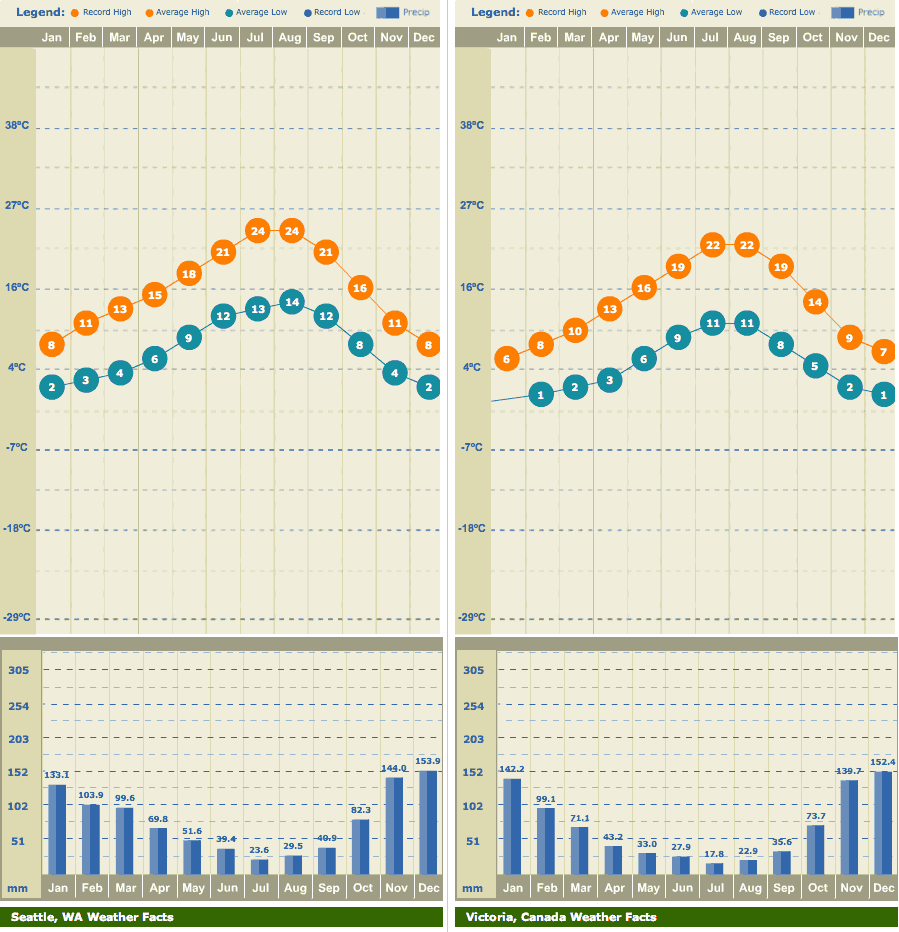
Hope the proper units don't confuse you....
dave
BTW: Ruth says she is going to get a new foamy for your next visit.
It's amazing, but those graphs exactly match the settings on my equalizer!
The proper units? Are those in metric inches, or feet?
There was nothing wrong with the old foamy, other than the claw marks and blood stains from the Grizzly Bear attack that I suffered (or was it actually one of those Giant Canadian mosquitoes?).
Best Regards,
Terry
Last edited:
- Home
- Loudspeakers
- Subwoofers
- Isobaric 8” subs
